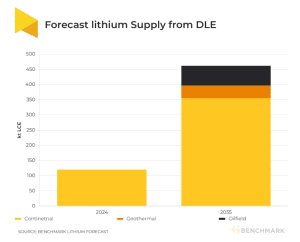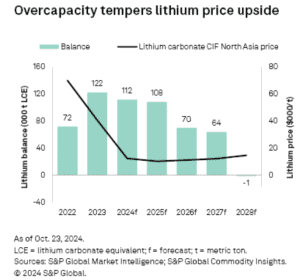The lithium market has entered a period of price decline, mainly because of weaker demand conditions and an oversupply of lithium carbonate in key regions.
In October, seaborne lithium carbonate prices for Asia dropped by 3.8%, hovering around $10,000 per metric ton, according to S&P Global Commodity Insights analysis.
The price dip reflects the seasonal winding down of demand typically seen at the end of the year when electric vehicle (EV) manufacturers prepare for a slowdown in post-peak sales. While September saw relative price stability, October’s downward shift reveals how the supply chain dynamics are pressing lithium markets. This is especially true in China’s case, which has been the dominant player in global EV sales in 2024.
- The slowdown underscores the lithium market’s key issue: maintaining demand growth and stabilizing prices amid fluctuating EV sales patterns.
China’s lithium market, the largest globally, saw prices fall by 3.3% in October, settling at about 73,000 yuan per ton. While a brief rebound was observed toward the end of the month, prices continue to reflect the underlying pressures of oversupply. This surplus is compounded by high inventories and the slower-than-expected uptake in EV markets outside of China.
The global market’s current inability to absorb excess supply effectively sets the tone for a persistent price slump, possibly extending into the next several years.
Li-FT Power Ltd. (TSXV: LIFT) recently announced its first-ever National Instrument 43-101 (NI 43-101) compliant mineral resource estimate (MRE) for the Yellowknife Lithium Project (YLP), located in the Northwest Territories, Canada.
An Initial Mineral Resource of 50.4 Million Tonnes at Yellowknife.
This maiden estimate is a major milestone for the company and marks a significant step forward in the project’s development. Li-FT Power’s upcoming mineral resource is expected to further solidify Yellowknife as one of North America’s largest hard rock lithium resources.
Click to learn more about lithium and Li-FT Power Ltd. >>
Strategic Adjustments Among Lithium Producers
In response to these challenges, major lithium producers are taking action to manage costs and production levels.
Companies like Sinomine Resource Group have opted to cut production in higher-cost regions. In Zimbabwe, for instance, Sinomine has minimized its petalite mining operations to prioritize spodumene extraction, which has a lower production cost. This shift reflects a broader industry trend, where companies focus on streamlining their operations to protect profit margins as market prices dip.
Another significant strategic move within the industry was the recent acquisition of Arcadium Lithium by Rio Tinto. It is a substantial shift in the company’s approach to the lithium sector. This acquisition is particularly important for Rio Tinto as it extends the company’s footprint in lithium production beyond its existing projects in Serbia and Argentina, allowing it to target markets outside of China more effectively.
One of Arcadium’s main competitive advantages lies in its exploration of direct lithium extraction (DLE) technology. DLE can revolutionize the lithium market by unlocking reserves in brine deposits previously considered difficult to exploit using traditional methods.
Presently, there are 13 DLE projects in operation, with total output projected to reach about 124,000 tonnes in 2024. According to Benchmark’s data, DLE technology can account for 14% of the global lithium supply by 2035, producing around 470,000 tonnes of LCE. This growth underscores the increasing role of DLE in meeting lithium demand for battery and EV markets.


Global Investments and Expanding Lithium Supply Chain
Investments in lithium production continue to grow despite the current market downturn, which signals optimism about long-term demand.
In October, General Motors made a notable move by increasing its stake in the Lithium Nevada project to 38% with an additional $625 million investment. This initiative speaks of a long-term commitment to secure local lithium supplies. It aligns with the U.S. government’s strategic push to strengthen domestic EV battery production and reduce reliance on imports.
The U.S. Department of Energy has already extended a substantial loan of $2.26 billion to support phase 1 construction of this project. The figure reveals the critical importance of domestic lithium resources for national energy goals.
While traditional methods dominate current production, the lithium market is also increasingly exploring technological advancements. General Motors and other industry stakeholders are actively pursuing direct extraction methods to unlock challenging lithium deposits.
By experimenting with DLE, the U.S.-based Lithium Nevada project aims to reduce environmental impacts and shorten production timelines. These technological investments indicate that despite current pricing challenges, there’s confidence in lithium’s long-term demand potential. More so as EV adoption grows and global green energy transitions accelerate.
Long-Term Market Forecast and Expected Price Recovery
Looking ahead, lithium prices could remain in a tight range. S&P Global Commodity Insight’s forecasts suggest that the price of lithium carbonate will stay between $9,924 and $11,627 per metric ton until 2026. This projection reflects the industry’s cautious outlook as companies expect that demand growth will take time to balance the current surplus.
- Analysts predict that a substantial price recovery may not materialize until 2028, with a forecasted rise to $14,659 per metric ton, or about a 20.8% increase, as the market finally shifts into a deficit.


The expected long-term supply shortage is largely tied to the anticipated increase in EV adoption and the renewable energy transition. Both of these demand drivers require significant lithium resources.
However, automakers worldwide are adjusting their production strategies to balance profitability with sustainable growth. This brings uncertainty to the exact timing of the demand shift that will absorb today’s excess supply.
In summary, the lithium market in 2024 reflects a complex blend of challenges and opportunities. Prices remain low due to oversupply and fluctuating EV demand, especially outside of China, but the long-term outlook for lithium still holds promise.
The lithium industry’s ability to adapt to today’s market conditions will shape the future landscape of this essential resource, ensuring its place in the global shift toward a sustainable energy future.



Vibracion mecanica
Sistemas de balanceo: fundamental para el funcionamiento uniforme y óptimo de las equipos.
En el mundo de la avances moderna, donde la rendimiento y la estabilidad del dispositivo son de alta trascendencia, los aparatos de equilibrado juegan un papel vital. Estos dispositivos adaptados están creados para equilibrar y asegurar elementos rotativas, ya sea en equipamiento industrial, transportes de desplazamiento o incluso en equipos caseros.
Para los especialistas en soporte de dispositivos y los profesionales, utilizar con sistemas de balanceo es esencial para promover el rendimiento suave y estable de cualquier mecanismo rotativo. Gracias a estas opciones modernas innovadoras, es posible disminuir sustancialmente las sacudidas, el zumbido y la presión sobre los rodamientos, mejorando la vida útil de elementos costosos.
Igualmente trascendental es el tarea que cumplen los equipos de equilibrado en la atención al comprador. El soporte especializado y el mantenimiento continuo usando estos aparatos habilitan proporcionar asistencias de excelente calidad, aumentando la satisfacción de los clientes.
Para los dueños de emprendimientos, la contribución en sistemas de balanceo y detectores puede ser clave para aumentar la efectividad y desempeño de sus sistemas. Esto es principalmente importante para los inversores que administran medianas y medianas organizaciones, donde cada elemento importa.
También, los aparatos de equilibrado tienen una gran uso en el área de la seguridad y el control de calidad. Posibilitan encontrar probables problemas, reduciendo reparaciones caras y daños a los aparatos. Además, los datos obtenidos de estos equipos pueden usarse para optimizar métodos y potenciar la visibilidad en motores de consulta.
Las áreas de uso de los dispositivos de calibración abarcan múltiples áreas, desde la elaboración de vehículos de dos ruedas hasta el monitoreo de la naturaleza. No importa si se trata de enormes fabricaciones productivas o reducidos espacios de uso personal, los aparatos de calibración son fundamentales para garantizar un rendimiento eficiente y sin riesgo de detenciones.
Why Choose DDoS.Market?
High-Quality Attacks – Our team ensures powerful and effective DDoS attacks for accurate security testing.
Competitive Pricing & Discounts – We offer attractive deals for returning customers.
Trusted Reputation – Our service has earned credibility in the Dark Web due to reliability and consistent performance.
Who Needs This?
Security professionals assessing network defenses.
Businesses conducting penetration tests.
IT administrators preparing for real-world threats.
Проверьте стоимость клининга в Москве, чтобы заранее понять бюджет. У нас — честные расценки и точное соблюдение всех сроков.
В последние годы клининг в Москве становится все более востребованным. Растущее число москвичей начинает доверять уборку своих объектов профессиональным клининговым компаниям.
Цены на клининг могут варьироваться в зависимости от специфики услуг. Например, стандартная уборка квартиры может стоить от 1500 до 5000 рублей.
Клининговые компании предлагают дополнительные услуги, такие как мойка окон и чистка мебели. Эти услуги могут значительно увеличить общую стоимость уборки.
Перед выбором клининговой фирмы рекомендуется ознакомиться с различными предложениями на рынке. Обращайте внимание на отзывы и рейтинг выбранной клининговой компании.
Все клининговые компании СПб разные — выберите профессионалов с отличной репутацией. Наш сервис ценят за честность и качество.
Сфера клининга в Санкт-Петербурге вырабатывает тренды. Многие компании предлагают широкий спектр услуг. Клининговые компании предлагают уборку жилых и коммерческих объектов.
Клиенты часто выбирают клининг для экономии времени. Благодаря этому они могут сосредоточиться на более важных делах. Клининговые услуги также становятся идеальным решением для занятых людей.
Клиенты выбирают клининг благодаря высокому профессионализму работников. Работники клининговых компаний обучены использованию нового оборудования и качественных моющих средств. Эффективное использование техники дает возможность достигать быстрого и качественного результата.
Разнообразие пакетов услуг позволяет каждому найти подходящее решение. Клиенты могут выбирать между разовыми и регулярными клининговыми услугами. Так клиенты могут подобрать наиболее удобный для себя вариант.
Можно отучиться на барбера в краткие сроки, получив навыки, которых ждут в индустрии. Всё — от А до Я.
Запись на курсы барбера набирает популярность среди молодежи. Количество школ, обучающих барберов, постоянно растет. Это связано с возросшим спросом на услуги мужских парикмахерских.
Курсы охватывают как техники стрижки, так и важные аспекты общения с клиентами. Учащиеся получают актуальные знания, которые помогут им построить карьеру в этой сфере. На занятиях акцентируется внимание на различных стилях и методах работы с волосами и бородой.
Выпускники имеют возможность трудиться в парикмахерских или запускать собственные проекты. Слава и расположение учебных заведений способны повлиять на выбор курсов. Необходи?мо внимательно изучить отзывы о курсах, прежде чем принять решение о записи.
В итоге, подходящие курсы барбера следует подбирать в зависимости от ваших амбиций и целей. С увеличением конкуренции на рынке, приобретение качественного образования становится важным фактором. Не забывайте, что успех в этой профессии зависит от постоянного обучения и практики.
德州撲克
你以為德州撲克只是比誰運氣好、誰先拿到一對 A 就贏?錯了!真正能在牌桌上長期贏錢的,不是牌運好的人,而是會玩的人。即使你手上拿著雜牌,只要懂得出手時機、坐在搶分位置、會算賠率——你就能用「小動作」打敗對手的大牌。本文要教你三個新手也能馬上用的技巧:偷雞、位置優勢、底池控制。不靠運氣、不靠喊 bluff,用邏輯與技巧贏得每一手關鍵牌局。現在,就從這篇開始,帶你從撲克小白進化為讓對手頭痛的「策略玩家」!